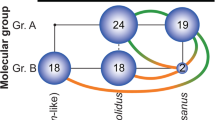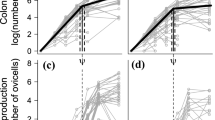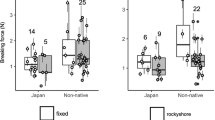Abstract
Shell growth rate is an important component of fitness in bivalve molluscs. Using the ω parameter computed from the von Bertalanffy growth equation, we quantitatively compared rates of annual shell grwoth among the hard clams Mercenaria mercenaria, M. campechiensis, and their hybrids sampled from a variety of habitats in the Indian River lagoon, Florida, USA, a zone of species overlap and natural hybridization. Our results indicate that the classical paradigm describing hard clam growth, in which growth rate is fastest in M. campechiensis, intermediate in hybrids, and slowest in M. mercenaria is not supported in the Indian River lagoon. Instead, M. campechiensis has a growth advantage in deep-water habitats in the northern section of our study area. In the central and southern sections of our study area, hybrids have a growth advantage over M. mercenaria in shallow-water habitats, but M. mercenaria has a growth advantage over hybrids in deep-water habitats. In all other sampled habitats, either growth rate among genotype classes is equal, or M. mercenaria has a growth advantage. This complex relationship between genotype and habitat-specific growth provides a mechanism for selection to act on hard clams in the Indian River.
Similar content being viewed by others
References
Abbott RT (1974) American seashells. 2nd edn. Van Nostrand Reinhold, New York
Arnold WS (1984) The effects of prey size, predator size, and sediment composition on the rate of predation of the blue crab, Callinectes sapidus Rathbun, on the hard clam, Mercenaria mercenaria (Linné). J exp mar Biol Ecol 80:207–219
Arnold WS, Marelli DC, Bert TM, Jones DS, Quitmyer IR (1991a) Habitat-specific growth of hard clams Mercenaria mercenaria (L.) from the Indian River, Florida. J exp mar Biol Ecol 147: 245–265
Arnold WS, Marelli DC, Lund C (1991b) Suitability of the southern Indian River lagoon for hard clam (Mercenaria spp.) culture. Florida Department of Agriculture and Consumer Services, Aquaculture Market Development Aid Program 1989–1990. Florida Department of Agriculture and Consumer Services, Tallahassee, Fla
Barker RM (1964) Microtextural variation in pelecypod shells. Malacologia 2:69–86
Bert TM, Arnold WS (1995) An empirical test of predictions of two competing models for the maintenance and fate of hybrid zones: both models are supported in a hard clam hybrid zone. Evolution 49:276–289
Bert TM, Hesselman DM, Arnold WS, Moore WS, Cruz-Lopez H, Marelli DC (1993) High frequency of gonadal neoplasia in a hard clam (Mercenaria spp.) hybrid zone. Mar Biol 117:97–104
Bertalanffy L von (1938) A quantitative theory of organic growth. Hum Biol 10:181–213
Blundon JA, Kennedy VS (1982) Mechanical and behavioral aspects of blue crab, Callinectes sapidus (Rathbun), predation on Chesapeake Bay bivalves. J exp mar Biol Ecol 65:47–65
Bricelj VM, Malouf RE (1980) Aspects of reproduction of hard clams (Mercenaria mercenaria) in Great South Bay, New York. Proc natn Shellfish Ass 70:216–229
Bricelj VM, Malouf RE (1984) Influence of algal and suspended sediment concentrations on the feeding physiology of the hard clam Mercenaria mercenaria. Mar Biol 84:155–165
Bricelj VM, Malouf RE, de Quillfeldt C (1984) Growth of juvenile Mercenaria mercenaria and the effect of resuspended bottom sediments. Mar Biol 84:167–173
Chestnut AF, Fahy WE, Porter HJ (1956) Growth of young Venus mercenaria, Venus campechiensis, and their hybrids. Proc natn Shellfish Ass 47:50–56
Costa SL (1986) Salinity. In: Barile DD, Rathjen W (eds) Report on rainfall events of September and October 1985 and the impact of storm discharge on salinity and the clam population (Mercenaria mercenaria) of the Indian River lagoon. Marine Resources Council, Melbourne, Florida, pp 47–123
Dillon RT Jr, Manzi JJ (1989) Genetics and shell morphology in a hybrid zone between the hard clams Mercenaria mercenaria and M. campechiensis. Mar Biol 100:217–222
Folk RL (1974) Petrology of sedimentary rocks. Hemphill Publishing Co., Austin, Texas
Gallucci VF, Quinn TJ II (1979) Reparameterizing, fitting, and testing a simple growth model. Trans Am Fish Soc 108: 14–25
Games PA, Howell JF (1976) Pairwise multiple comparison procedures with unequal N's and/or variances: a Monte Carlo study. J educ Statist 1:113–125
Haven D, Andrews JD (1956) Survival and growth of Venus mercenaria, Venus campechiensis, and their hybrids in suspended trays and on natural bottoms. Proc natn Shellfish Ass 47:43–49
Haven DS, Loesch JG (1973) An investigation into commercial aspects of the hard clam fishery and development of commercial gear for the harvest of molluscs. Annual Contract Report, Contract No. 3-124 R, Virginia Institute of Marine Science, Gloucester Point, Virginia
Irlandi EA, Peterson CH (1991) Modification of animal habitat by large plants: mechanisms by which seagrasses influence clam growth. Oecologia 87:307–318
James FC, McCulloch CE (1990) Multivariate analysis in ecology and systematics: panacea or Pandora's box? A Rev Ecol Syst 30: 291–308
Jones DS, Quitmyer IR, Arnold WS, Marelli DC (1990) Annual shell banding, age, and growth rate of hard clams (Mercenaria spp.) from Florida. J Shellfish Res 9:215–225
Juanes F (1992) Why do decapod crustaceans prefer small-sized molluscan prey? Mar Ecol Prog Ser 87:239–249
Levinton JS (1982) Marine ecology. Prentice-Hall, Inc., Englewood Cliffs, New Jersey
McCall D, Cook JG, Lasater JA, Nevin TA (1970) A survey of salinity levels in the Indian River-Banana River complex. Bull envir Contam Toxic 5:414–421
Menzel RW (1961) Seasonal growth of the northern quahog, Mercenaria mercenaria, and the southern quahog, M. campechiensis, in Alligator Harbor, Florida. Proc natn Shellfish Ass 52:37–46
Menzel RW (1962) Seasonal growth of northern and southern and southern quahogs, Mercenaria mercenaria and M. campechiensis, and their hybrids in Florida. Proc natn Shellfish A55 53:111–119
Menzel RW (1989) The biology, fishery and culture of quahog clams, Mercenaria. In: Manzi JJ, Castagna M (eds) Clam mariculture in North America. Developments in Aquacluture and Fisheries Science. Vol 19. Elsevier Science Publishing Company Inc, New York, pp 201–242
Neff NA, Smith GR (1978) Multivariate analysis of hybrid fishes. Syst Zool 28:176–196
Peterson CH (1983) A concept of quantitative reproductive senility: application to the hard clam, Mercenaria mercenaria (L.)? Oecologia 58:164–168
Peterson CH, Summerson HC, Duncan PB (1984) The influence of seagrass cover on population structure and individual growth rate of a suspension-feeding bivalve, Mercenaria mercenaria. J mar Res 42:123–138
Rawson PD, Hilbish TJ (1991) Genotype-environment interaction for juvenile growth in the hard clam Mercenaria mercenaria (L.). Evolution 45:1924–1935
Rice JD, Trocine RP, Wells GN (1983) Factors influencing seagrass ecology in the Indian River lagoon. Fla Scient 46:276–286
SAS Institute (1985) SAS user's guide: statistics. Version 5 edn. SAS Institute, Cary, North Carolina
Smith NP (1987) An introduction to the tides of Florida's Indian River lagoon. I. Water levels. Fla Scient 50:49–61
Smith NP (1993) Tidal and wind-driven transport between Indian River and Mosquito Lagoon, Florida. Fla Scient 56: 235–246
Sokal RR, Rohlf FJ (1981) Biometry. The principles and practice of statistics in biological research. 2nd edn. W.H. Freeman & Co., New York
Sunderlin JB, Breuner M, Castagna M, Hirota J, Menzel RW, Roels OA (1975) Comparative growth of hard shell clams (Mercenaria mercenaria Linné and Mercenaria campechiensis Gmelin) and their F1 cross in temperate, subtropical and tropical natural waters and in a tropical artificial upwelling mariculture system. Proc Wld Maricult Soc 6:171–183
Vaughan DE (1988) Clam culture: state of the art in Florida, USA. J Shellfish Res 7:546
Whetstone JM, Eversole AG (1981) Effects of size and temperature on mud crab, Panopeus herbstii, predation on hard clams, Mercenaria mercenaria. Estuaries 4:153–156
White C (1986) Biological and environmental factors affecting the clamming industry. In: Busby D (ed). An overview of the Indian River clamming industry and the Indian River Lagoon. University of Florida, Gainesville, pp 9–13 (Florida Sea Grant Extension Program, Tech Pap No 44)
Author information
Authors and Affiliations
Additional information
Communicated by N.H. Marcus, Tallahassee
Rights and permissions
About this article
Cite this article
Arnold, W.S., Bert, T.M., Marelli, D.C. et al. Genotype-specific growth of hard clams (genus Mercenaria) in a hybrid zone: variation among habitats. Marine Biology 125, 129–139 (1996). https://doi.org/10.1007/BF00350767
Received:
Accepted:
Issue Date:
DOI: https://doi.org/10.1007/BF00350767




